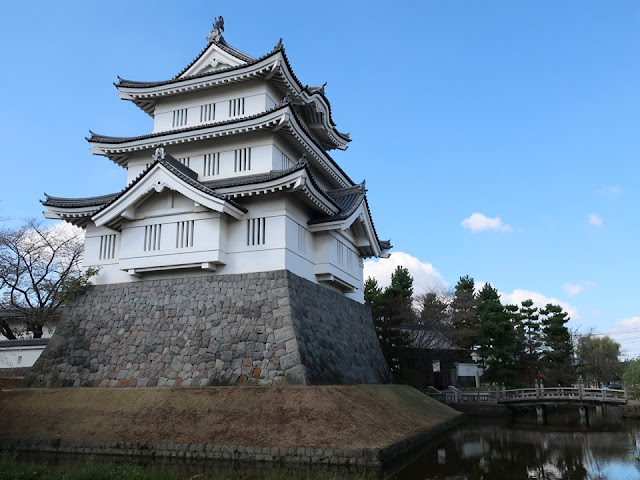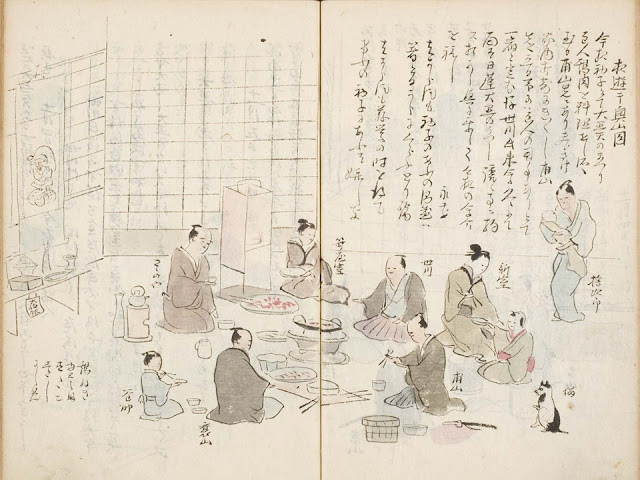再建された忍城三階櫓、内部は博物館の展示施設です
Gyoda is around 50km northwest of the central Tokyo. There was a battle in the internal war time (the 16th century); it is near the Nakasendou (kaidou or highway).
埼玉県行田市は、中山道近くの城下町です。
秀吉の小田原平定の戦いでは、石田三成軍の水攻めに耐えました。「忍」という名前で仕掛けがありそうに感じますが、忍者は関係ありません。維新後に取り壊されました。
The museum was built at the site of the former Oshi-castle’s main citadel. You can take photos in the exhibition rooms if a curator accompanies you with an approval request in advance. I couldn’t take photos this time, unfortunately.
忍城の本丸跡地に博物館があります。展示室内の写真撮影は、事前に申し込んで学芸員さんに立ち会っていただければ可能なのですが、折悪しく、訪問時は撮影ができませんでした。
Keio Object Hub https://objecthub.keio.ac.jp/ja/object/12533
The pleasant samurai’s diary in 1861 and 1862 is exhibited. He was in a low class, was a drunkard and wrote about parties and cuisines together with illustrations. He enjoyed his life enough!
石城日記という楽しい絵入り日記が展示されていました。忍藩の下級武士・尾崎石城さんが1861年から翌年の日常を記録しています。酒吞みのお侍さんで、料理や宴会の絵も多く、毎日楽しんでいたのだなあと思います。
The photo of the factory is on the brochure of the museum. Tabi is a part of a photo in https://publicdomainq.net/woman-portrait-kimono-0024384/.
Manufacturing of tabi (split-toe socks) started in the end of the 17th century. It prospered in the late 19th century due to introducing sewing machines and 80% of tabi socks were made in Gyoda in 1938. However, the production volume reduced because people gradually stop wearing kimono. There are many exhibits about tabi manufacturing.
There were many female workers; they ate “Jelly Fries“ as snack, which are deep-fried foods of mashed potato and okara (soy pulp, byproduct of tofu). It was a very factory town. Those are popular local foods even until now.
Gyoda is a filming location of popular TV drama “Rikuou” (2017). Tabi company succeeded to develop shoes for athletics in it. (Rikuou: https://www.tbs.co.jp/rikuou_tbs/ Japanese site)
行田では、17世紀の終わりから足袋の製造が始まり、ミシンが入った、明治の中頃以降に全盛期になり、昭和13年には、全国の80%を製造するようになりました。着物の衰退でその後、生産は減ります。関連の展示がたくさんあります。
たくさんの女工さん達がいたのですが、そのおやつとして、ゼリーフライがありました。おからとジャガイモを混ぜて揚げたコロッケに似た料理です。工場の町らしいですね。
行田は、足袋会社がランニングシューズの開発に成功するというTVドラマ「陸王」(2017)の撮影舞台にもなりました。
There was a great fire in 1846, then many fire-proof buildings were built. Those buildings exude nostalgic atmosphere. The Agency for Cultural Affairs designated Gyoda as a cultural heritage “A City of Tabi Storehouses Supporting the Kimono Culture from the Feet” (https://japan-heritage-gyoda.jp/en/).
1846年に大火があり、その後、火に強い蔵作りの建物がたくさん建てられました。「和装文化の足元を支え続ける足袋蔵のまち行田」として、文化庁が日本遺産に認定しています。(https://japan-heritage-gyoda.jp/ja/)。その他の展示品では、鳶職人の勇壮な半纏や道具が目を引きました。
There is a Gyoda themed movie “The Floating Castle” (2012). In 1590, Oshi castle was surrounded by 20,000 soldiers. The enemy army built embankment around the castle and poured water from the rivers; it looked like a floating castle. However, only 500 warriors protected the castle until their big boss (Hojo clan) in Odawara hauled down a flag. (Reference: https://en.wikipedia.org/wiki/The_Floating_Castle )
ホールでは、忍城が映画になった『のぼうの城』(2012)の舞台がパネルで紹介されています。1590年、石田三成が率いる2万の豊臣軍に対し、500の兵で城を守った籠城戦です。小田原城の降伏まで水攻めに耐えて、水に浮くのかと恐れられ「忍の浮城」と恐れられたそうです。
Visited in October, 2021
Official website: https://www.city.gyoda.lg.jp/soshiki/kyodohakubutsukan/index.html
(in Japanese), accessed in January, 2022
Previous post (Museum in the other castle city): Tsuchiura City Museum、土浦市立博物館
Next post (Resting facility for high class people on the Nakasendou highway): Kami-Toyooka Chaya-honjin、上豊岡の茶屋本陣







Comments
Post a Comment